The Apple iPad Air 2 Review
by Joshua Ho on November 7, 2014 9:30 AM EST- Posted in
- Tablets
- Apple
- Mobile
- iOS
- ipad Air 2
Display
While the display is important on a smartphone, by virtue of its sheer size tablets seem to have a more critical need for a good display. With a tablet there’s a great deal more potential for usage models such as drawing/sketching and photo/video editing. In addition, reading books or watching videos is far more common on a tablet, which means that poor resolution, response time, and/or contrast can be quite visible and painful to live with. In order to test this, we use our standard suite of tools, which include SpectraCal’s CalMAN 5 and X-Rite’s i1Pro2 spectrophotometer to make sure that our color readings are as accurate as possible. Colorimeters in practice have varying levels of color accuracy due to their design, and as a result these are only used to verify contrast and gamma curves. As previously mentioned, we test against sRGB gamut as it’s the de facto standard for displays and web content. It’s definitely not a perfect standard by any means, but until a wider gamut becomes standard it’s the one to test against.
Before we get into the objective tests though, there’s a lot of talk about that isn’t easily measured. On the simpler side, the display resolution where I can see a noticeable difference when compared to the iPhone 6 Plus and similarly high resolution devices. The 2048x1536 resolution is nothing to be ashamed of, but when stretched to a 9.7 inch display this means that it’s relatively easy to notice pixelated areas on various curves. At a normal viewing distance though it’s not an obvious issue and I didn’t have any issues with eye strain. There could be some value to going to higher resolutions for the iPad Air 3, but barring some major breakthrough in TFTs or backlight technology such a move would incur a significant cost in power due to losses in backlight efficiency as the LEDs approach maximum power draw.
Speaking of LEDs at maximum power draw, outdoor visibility is often a critical use case. While we focus on maximum brightness, in truth this is really just one part of the equation as high reflectance can effectively erase all of the gains that one can have from higher brightness. Unfortunately, I don’t have the proper equipment to objectively test this, although the test will be ready for next year. In practice, I can definitely see a difference in mirror/specular reflections on the tablet when comparing the Galaxy Note 4, although it’s harder to tell when comparing against the iPhone 6. I can definitely see a difference in what is reflected though, as there’s a noticeable purple hue to white reflections in certain angles which could be a magnesium fluoride coating similar to what one might find on glasses or camera lenses. There’s no obvious flaring issues though, and in practice I don’t see any real degradation of clarity. The improvement from the iPad Air is dramatic, especially as the addition of lamination makes the display noticeably closer to the glass and reduces the reflections that result from the air gap. This change also helps with the viewing angles on the iPad Air 2, which were already quite good with the iPad Air due to the chevron-shaped subpixels. As I said with the iPhone 6 review, this helps to ensure that there's much less color shifting when changing viewing angle, although there is a noticeable shift towards purple in some viewing angles which is mostly noticed on pure black but hard to see in any other case.
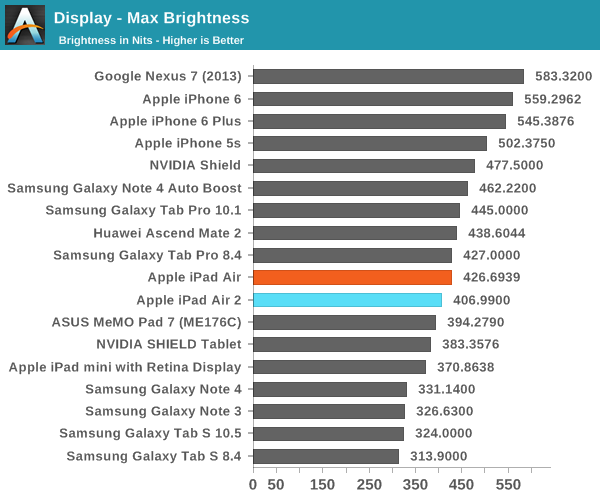

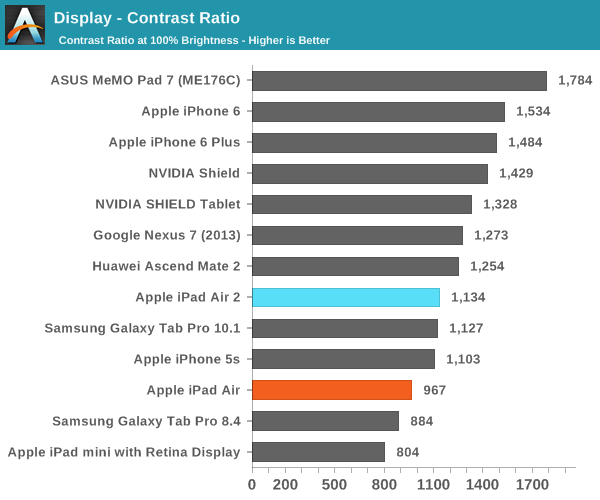
On the actual display characteristics though, we don’t see too much of a difference. Brightness and contrast are quite close to the original iPad Air, which suggests that we’re looking at the same exact display, although production variances may have an effect on things.
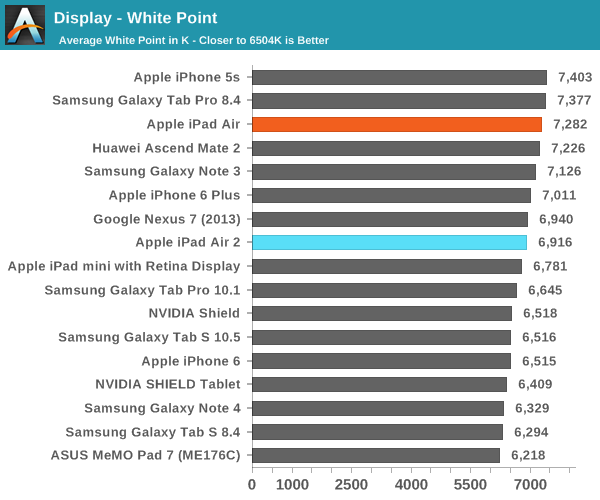
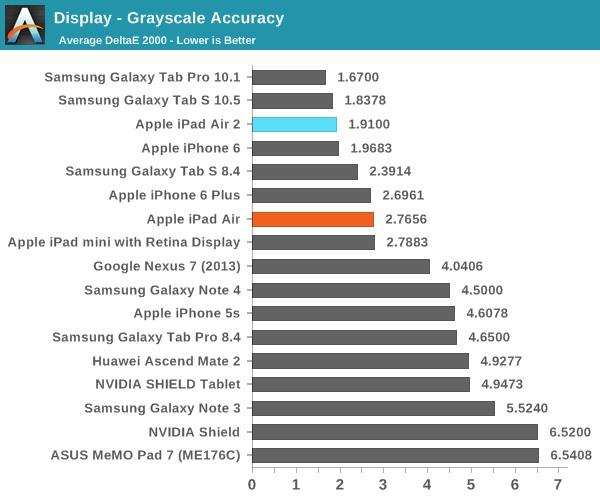
In grayscale, we see some level of improvement to the calibration, although it’s hard to tell whether this is the product of production variance or some level of improvement. In practice grayscale tones are definitely well-rendered, and the blue tint isn’t really significant here. There’s really nothing else to be said, as the visible difference from a reference monitor would be difficult, if not impossible to spot.

For the saturation sweep, which is the next aspect under test we see a similar pattern. While there’s some oversaturation on the blues, there aren’t any other significant issues. The display on the iPad Air 2 is probably similar, if not the same type as the one we’ve seen in the iPad Air as both have the same gamut.
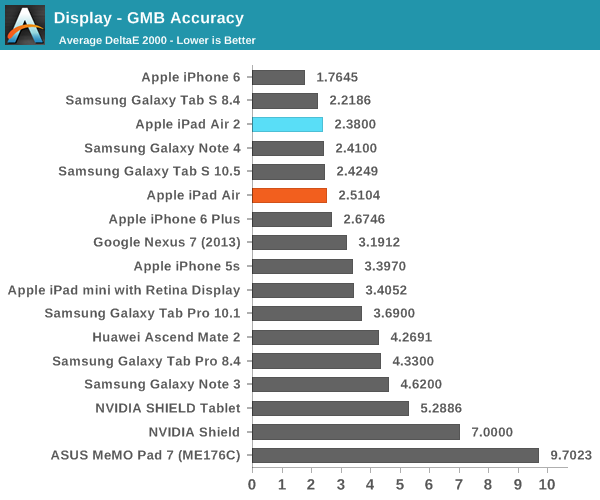
On the GMB ColorChecker, we can generally pick out any issues with display calibration that the saturation sweep won’t show as this test emphasizes hue comparisons along with some grayscale testing. In practice, the iPad Air 2 doesn’t have any issues here as evidenced by the low average error. While there’s noticeable blue shift on some of the hues this shouldn’t be a major problem.
Overall, the quality of the display calibration in the iPad Air 2 is pretty much as good as it gets. While I can name some problems, they’re all minor at best and effectively nit-picking. The fact that I can say this about a tablet display is definitely good news for the state of the industry, as things haven’t quite devolved into a race to the bottom with corners cut in every possible area.
There are some issues with the display overall in terms of peak luminance, but these are likely to be due to the larger display size. These differences when compared to smaller smartphone displays are likely to be due to issues with scaling of the thin film transistor technologies common in smartphone-size displays to tablet-size displays as LTPS backplanes become increasingly expensive to make due to the higher variability involved in the process when compared to IGZO and amorphous silicon processes. Unfortunately, an IGZO backplane seems to gate performance in some key areas as we don’t quite see the levels of brightness and contrast that we do on the iPhone 6 despite lower pixel density.





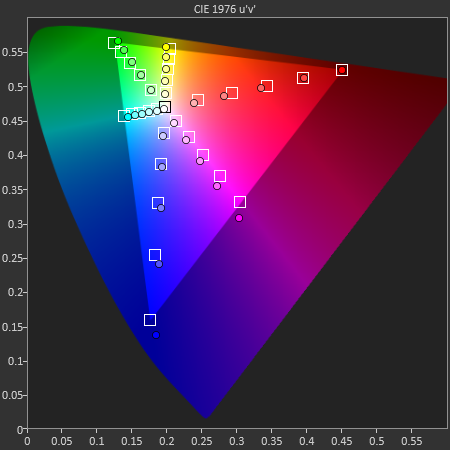
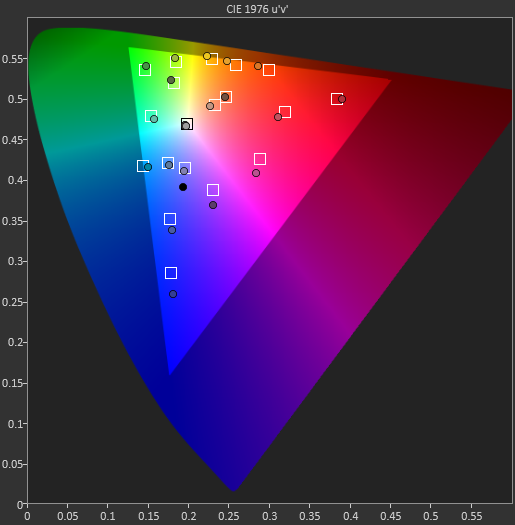








226 Comments
View All Comments
tralalalalalala40 - Thursday, November 13, 2014 - link
Oh the strained logic of a sterdroid user. One employee of a news site goes and works somewhere else, everyone left behind still works for that employee. lolapplelover2885 - Saturday, November 8, 2014 - link
I consider myself an apple fan girl for life. I bought my MacBook Pro in 09 and no issues. My finacee has a HP desktop that does. I fear the blue screen of death soon. I want to convert him to the apple side. He has the newest macbook pro 2012 I want him to get an iphone he has a Motorola phone. Most Android and Window's are not as flexible as the Apple. Yes, IOS has issues like other platforms. However, Apple's products are designed to last longer than it's competitors. I had bad taste of both Windows & Android now. I owned a Samsung Galaxy S and Windows Nokia Lumia the problem is their software & battery life. Yes, apple's products are expensive but in the long run it is worth every penny spent on a beautiful product that is going to last. I am off to buy an Ipad Air 2 something I have been waiting on for a while. I'll do a combo pack and give it to myself as a birthday present. I'm a tech junkie and a student. Did you know you can use Window's office mobile on all devices? You no longer need those giant desktop thing's. I don't need a USB to find mystuff when I have airdrop and icloud if you need extra storage use that as your backup for files. I also use Google Drive to do my school work. Good luck with all your apple needs.Ilias78 - Saturday, November 8, 2014 - link
Lol women... go back to your kitchen.Commodus - Sunday, November 9, 2014 - link
I'm sorry, I'm gonna have to call out this sexism -- criticize the issues, not the gender, please.zodiacsoulmate - Saturday, November 8, 2014 - link
lolmaximumGPU - Sunday, November 9, 2014 - link
"giant desktop things" are not used just for office you know..asleepy - Saturday, November 8, 2014 - link
Sound vibrates through the screen even at low volume levels to such an extent that people's fingertips are going numb and they're returning the Air 2s for refunds... yet no mention of that??? Welcome to Apple Corporation, Anandtech. And goodbye.Commodus - Sunday, November 9, 2014 - link
Maybe because it's not as much of an issue as you think it is? If you'd believed the Antennagate sky-is-falling types, Apple was going to have to recall the iPhone 4 and face disastrous financial results... turned out that the problem, while real, was seriously overblown.I've felt it, and it's slightly weird, but I don't think I'd call it a dealbreaker.
tralalalalalala40 - Thursday, November 13, 2014 - link
People's fingernails are literally getting stuck in the gap of the note 4 and people are having to amputate fingers. It's horrible. Goodbye corporate Samsung!!#@$carloshehe - Sunday, November 9, 2014 - link
I got the iPad Air 2 yesterday. I can do more with it I could ever do with a Nexus. I have an Android phone but I wouldn't take a Nexus tablet if you have it to me for free.